Plex is the ultimate media hub, serving and transcoding content on your local network to almost any client device. But did you know you can also access your Plex library remotely, when you're away from home?
The process of opening your Plex library to the outside world can be really easy, but it can be more difficult if your router isn't working right. Our comprehensive guide to getting this job should help.
Note: Due to the fantastic features it offers, a Plex Pass is well worth the money Plex Pass:What do you get for your money? Plex Pass:What do you get for your money? To find out whether or not you need a Plex Pass, you first need to know exactly what you're getting for your money. Read more . However, you don't need a Plex Pass to remotely access your media. The remote access feature is available to everyone, free of charge.
Let's make a couple of assumptions before starting this tutorial:
If you've stumbled upon this tutorial and are completely new to Plex, you should read our beginner's guide to Plex. Your guide to Plex:The Awesome Media Center. Your guide to Plex:The Awesome Media Center. Movies and TV shows, you need to install Plex. And this is the only guide to getting started with Plex that you will ever need to read. Read More
For most people, this may be the only step required, and it's ridiculously easy. Simply log in to Plex.tv, then click the orange border Launch button at the top right. You may also need to choose which user if you have set up multiple users and enter your PIN if you have secured it. Be sure to select who your admin user is, as you'll need to adjust some settings.

Then click on the Settings icon on the top right (the one with the crossed wrench and screwdriver).

Select the Server tab, then Remote Access From the menu on the left. You should see a button to Enable remote access; click on that.

After a few moments, you may see a green message that says “Fully accessible from outside your network.” If that's the case, congratulations! You can skip the rest of the tutorial, as now you can access any of your Plex library remotely from any browser or client app by simply logging into your Plex account.

If you still see the message. “Not available outside your network,” continue with the steps below. Don't worry, this could be a very easy fix.
uPnP / NAT-PMP are router features that allow Plex to negotiate directly with your router, without you needing to manually configure port numbers or anything that complicated.
Plex tells your router that you are here on the internal network, and that you would like to be available to the external Internet. It asks the router to open a port and forward incoming traffic on that port, to a specific port on your Plex server. Then, when a Plex request comes in from the internet, the router knows exactly where to send that data packet on its internal network. Without that automatic port setting, your router would just drop the packet, not knowing what to do with it.
Your router may not have uPnP enabled by default, in which case you'll need to turn it on. This process will vary depending on the manufacturer of your router.
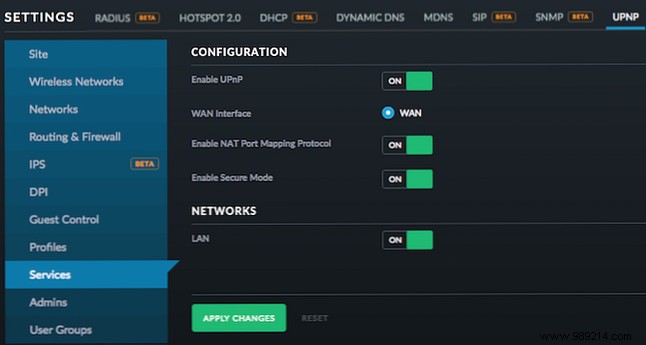
On my Unifi Security Gateway, for example, I can find the option under Settings> Services> uPnP . Turn on both UPnP and NAT port mapping if the option is there. Here are instructions for Linksys and Netgear routers. If yours is from another manufacturer, just google “enable upnp” followed by the name of your router.
If, after enabling uPnP and rebooting your router, Plex still says it can't be reached from the external network, your router's uPnP protocol may be incompatible. If that's the case, continue to the next step.
We should also note that some people believe that uPnP is a security risk. 10 Ways Your Router Isn't As Secure As You Think 10 Ways Your Router Isn't As Secure As You Think. -by wireless hijackers. Read More Even the FBI suggested disabling it at one point, but routers have since been upgraded and the feature is more secure now (note that Enable Secure Mode in the screenshot above). But if you don't feel comfortable enabling uPnP or NAT-PMP, you should also continue to the next step to configure port forwarding manually.
If you still can't remotely access your Plex content, this step may be the solution you need:Set up port forwarding What is port forwarding and how can it help me? [MakeUseOf Explains] What is port forwarding and how can it help me? [MakeUseOf Explains] Do you cry a little inside when someone tells you there's a port forwarding problem and that's why your new app won't work? Your Xbox won't let you play games, your torrent downloads are being refused... Read More .
This means that you will have to tell your router that you want data packets on a certain port to be forwarded to your internal Plex server. You need two pieces of information to do this:the internal IP address of the Plex server and the port number of the Plex server.
Before we continue, it is worth clarifying something that always confuses beginners: When we talk about IP addresses and ports, we need to be clear about whether we are talking about the internal network (device connected to your router) or external (Internet). Every router that is connected to the Internet has a public external IP address. You can literally ask Google "What is my IP?" and it will tell you:
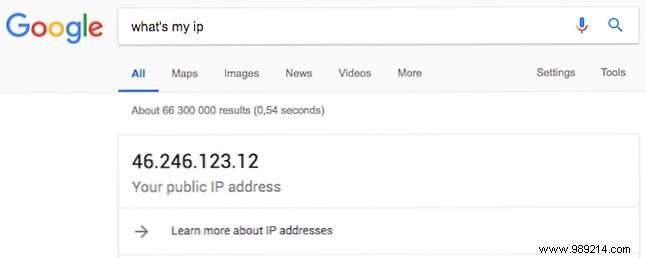
You only have one IP address, and your ISP provides it to you. The exception to this is if your computer is running a VPN connection. 11 Reasons You Should Be Using a VPN 11 Reasons You Should Be Using a VPN Virtual Private Networks are affordable and easy to use. Here are some reasons why you should be using a VPN if you're not already. Read More This address will change every time your router reboots.
You also have internal IP addresses. These are assigned by your router, and will be in the form 10.x.x.x or 192.168.x.x and these are special IP addresses reserved for private use. They cannot be accessed by the outside world. These can also change every time your router reboots. Each device on your network will have its own internal IP address.
So the first bit of information you need to know is the private internal IP address of your Plex server. We can't tell you which one is yours, because it's unique to your home network. If you already know, great, scroll down a bit. If you don't, we'll help you figure it out.
The easiest way to find this is to go back to the Plex Remote Access Settings page and click the Show Advanced button in the top right. You'll see additional information appear, like this:
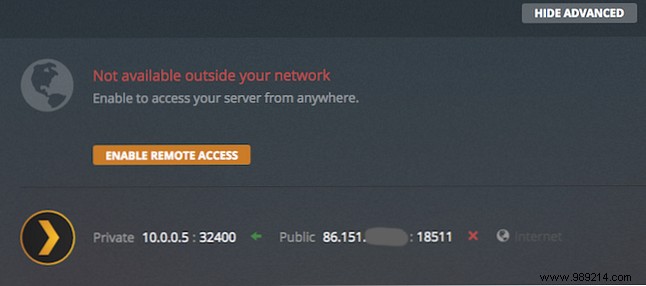
See where it says Private:10.0.0.5:32400 ? That is what we need. This tells me that my Plex server has an IP address of 10.0.0.5 and an internal port number of 32400. Plex's default port is always 32400, in fact while your IP will vary, the port should also read 32400. /P>
Next, you need to log back into your router's admin page and find the section on port forwarding (instructions for Linksys and Netgear). It will ask for at least five pieces of information:
The exact terminology may be different for you, but if there are any other options, just leave those options at default and press Save. This is an example of how to set up port forwarding on a Unifi system:
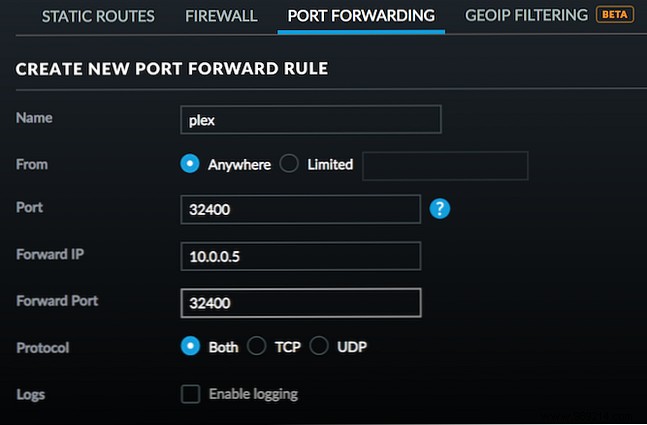
Finally, reboot your router, go back to the Plex server settings, and try to enable remote access again. If you have changed the public-facing port number as defined above, click Show advanced button again, and choose to manually specify the public port.

Finally, you should now be able to access your Plex library when you're away from home.
However, your devices are likely set to obtain an IP automatically via DHCP, which means they could change when you reboot your router. The rule you just set up for port forwarding will break if that happens, as it will forward Plex packets to the wrong internal IP address.
Unless you've enjoyed the process of manually setting up a port forwarding rule, we suggest taking one last step to ensure your IP doesn't change. It's called DHCP Reservation , and means that the next time a device requests an IP via DHCP, it will receive the one you specified. This is slightly different than a static IP address. What is a static IP address? How can I get one and its advantages / disadvantages? What is a static IP address? How can I get one and its advantages / disadvantages? Not usually fixed, but within specific ranges A static IP address does not change. What are the advantages of this and why would I want one? Read More
To set this up, you'll need to go to your router's admin page. You are typically looking for the LAN Settings tongue. On a Unifi system, you can click the device from Client list, then in the Settings tab, and expand the Network dropdown. Check the box to Use fixed IP address , and save-it should default to whatever IP you have now, but feel free to change it to something more memorable, then reconnect the device to get the new IP. Learn how to set up a DHCP address reservation on Linksys and Netgear routers.
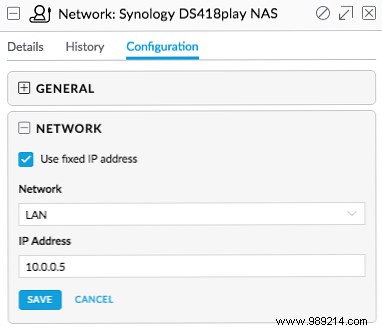
If all the talk of networks and IP addresses has you intrigued, check out our beginner's guide to home networking. Everything you need to know about home networks Everything you need to know about home networks Setting up a home network isn't as difficult as you think. it is. Read further to learn more. Or if you're having trouble with an unreliable Wi-Fi connection and want to learn more about the Ubiquity Uniquity system mentioned in this review, read how Unifi can fix your Wi-Fi problems. Ay What is Ubiquiti UniFi and how can you fix your Wi-Fi problems? Almost everyone has experienced limited Wi-Fi functionality and poor coverage, especially in crowded areas. A Uniqui network from Ubiquiti could be the solution. This is what you need to know. Read more.